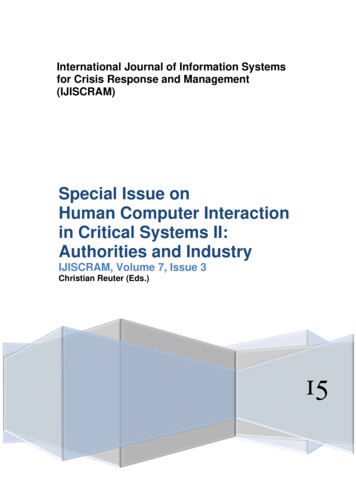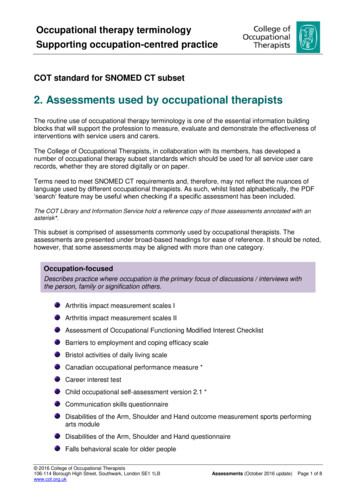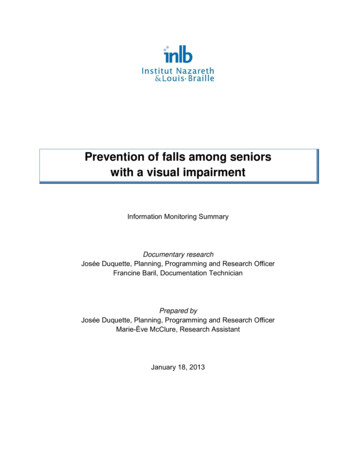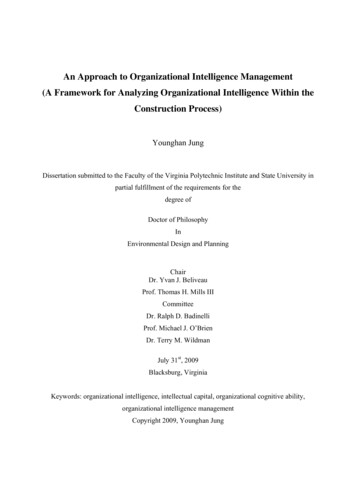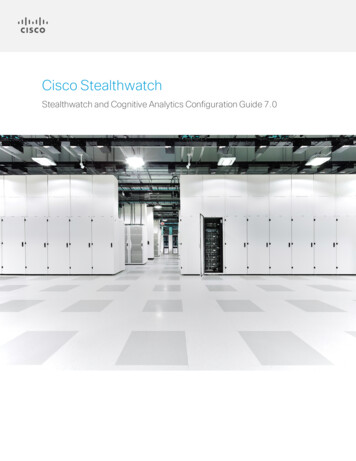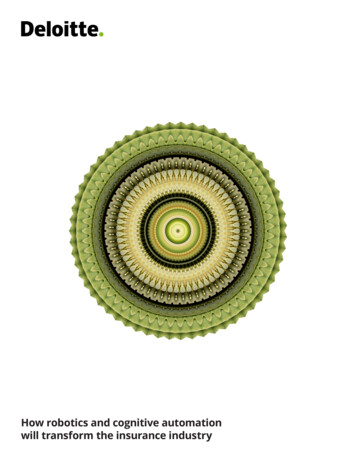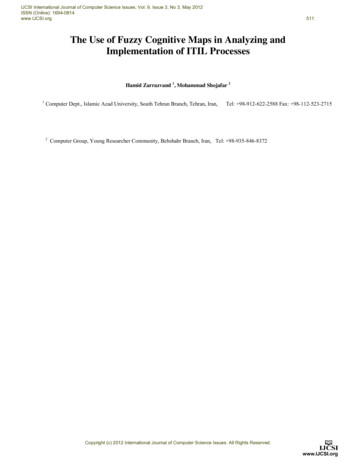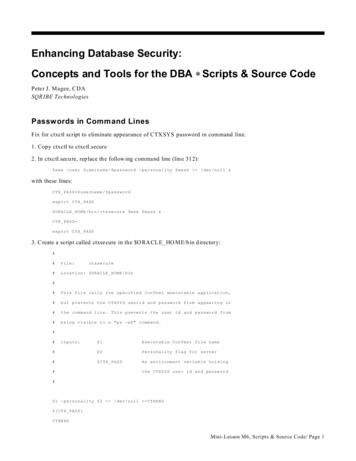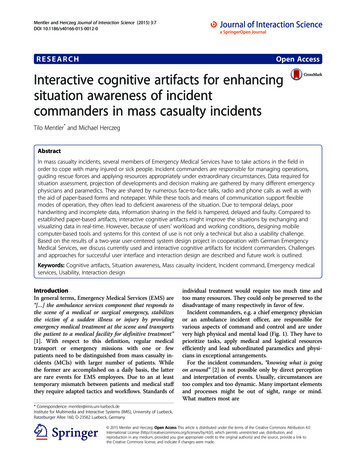
Transcription
Mentler and Herczeg Journal of Interaction Science (2015) 3:7DOI 10.1186/s40166-015-0012-0RESEARCHOpen AccessInteractive cognitive artifacts for enhancingsituation awareness of incidentcommanders in mass casualty incidentsTilo Mentler* and Michael HerczegAbstractIn mass casualty incidents, several members of Emergency Medical Services have to take actions in the field inorder to cope with many injured or sick people. Incident commanders are responsible for managing operations,guiding rescue forces and applying resources appropriately under extraordinary circumstances. Data required forsituation assessment, projection of developments and decision making are gathered by many different emergencyphysicians and paramedics. They are shared by numerous face-to-face talks, radio and phone calls as well as withthe aid of paper-based forms and notepaper. While these tools and means of communication support flexiblemodes of operation, they often lead to deficient awareness of the situation. Due to temporal delays, poorhandwriting and incomplete data, information sharing in the field is hampered, delayed and faulty. Compared toestablished paper-based artifacts, interactive cognitive artifacts might improve the situations by exchanging andvisualizing data in real-time. However, because of users’ workload and working conditions, designing mobilecomputer-based tools and systems for this context of use is not only a technical but also a usability challenge.Based on the results of a two-year user-centered system design project in cooperation with German EmergencyMedical Services, we discuss currently used and interactive cognitive artifacts for incident commanders. Challengesand approaches for successful user interface and interaction design are described and future work is outlined.Keywords: Cognitive artifacts, Situation awareness, Mass casualty incident, Incident command, Emergency medicalservices, Usability, Interaction designIntroductionIn general terms, Emergency Medical Services (EMS) are“[ ] the ambulance services component that responds tothe scene of a medical or surgical emergency, stabilizesthe victim of a sudden illness or injury by providingemergency medical treatment at the scene and transportsthe patient to a medical facility for definitive treatment”[1]. With respect to this definition, regular medicaltransport or emergency missions with one or fewpatients need to be distinguished from mass casualty incidents (MCIs) with larger number of patients. Whilethe former are accomplished on a daily basis, the latterare rare events for EMS employees. Due to an at leasttemporary mismatch between patients and medical staffthey require adapted tactics and workflows. Standards ofindividual treatment would require too much time andtoo many resources. They could only be preserved to thedisadvantage of many respectively in favor of few.Incident commanders, e.g. a chief emergency physicianor an ambulance incident officer, are responsible forvarious aspects of command and control and are undervery high physical and mental load (Fig. 1). They have toprioritize tasks, apply medical and logistical resourcesefficiently and lead subordinated paramedics and physicians in exceptional arrangements.For the incident commanders, “knowing what is goingon around” [2] is not possible only by direct perceptionand interpretation of events. Usually, circumstances aretoo complex and too dynamic. Many important elementsand processes might be out of sight, range or mind.What matters most are* Correspondence: mentler@imis.uni-luebeck.deInstitute for Multimedia and Interactive Systems (IMIS), University of Luebeck,Ratzeburger Allee 160, D-23562 Luebeck, Germany 2015 Mentler and Herczeg. Open Access This article is distributed under the terms of the Creative Commons Attribution 4.0International License (http://creativecommons.org/licenses/by/4.0/), which permits unrestricted use, distribution, andreproduction in any medium, provided you give appropriate credit to the original author(s) and the source, provide a link tothe Creative Commons license, and indicate if changes were made.
Mentler and Herczeg Journal of Interaction Science (2015) 3:7Page 2 of 9The project resulted in an advanced prototype of aninformation system for managing MCIs, which hasundergone formative and summative evaluations [3–5].Related work has been conducted with respect to information exchange with maps and tactical signs in emergencies [6] and combinations of computer-based andpaper-based area maps [7].Mass casualty incidentsFig. 1 Chief Emergency Physician (“Leitender Notarzt”) andAmbulance Incident Officer (“Org.-Leiter”) assessing the triage areaduring an MCI exercise in Germany a steady flow of information between incidentcommand and operational units, usable tools and aids for information management.Theses aspects represent complex challenges in preparation of and during a MCI. Domain experts and toolproviders need to cooperate in order to develop practicalsolutions. The basic research questions of this contribution are, which cognitive artifacts are currently used byincident commanders and how interactive cognitive artifacts have to be designed in order to ease and optimizeincident commanders’ work.Background and related workIn the following sections, MCIs are characterized briefly.Then the context of use is related to situation awarenessand cognitive artifacts. Finally, established equipmentwhich is currently in use by incident commanders inGermany will be described. Although national laws andlocal regulations might affect structures and practices ofEMS in other countries, our findings can be abstractedand transferred. They are based on several actions during a two-year user-centered system design project withEMS: observations of two MCI exercises in differentfederal states; five workshops with EMS employees of differentrescue services at which concepts and prototypesregarding the interactive system were presented andevaluated formatively; numerous interviews with incident commanders,emergency physicians and paramedics; two days of discussions with professional visitors atour booth at a large emergency trade fair.Train and airplane accidents or terrorist attacks often result in publicly recognized MCIs. Nevertheless, evenminor events can generate “more patients at one time thanlocally available resources can manage using routine procedures” [8]. Contributing factors can be time of occurrence(e.g. at night), location of accident (e.g. freeway, poorly accessible areas), weather conditions (e.g. heavy rain, snow,storm), and utilization of responsible EMS (e.g. while being in charge of other events at the same time).While all involved paramedics and emergency physicians have to adapt treatment strategies and other operating principles, incident commanders have to deal withquestions of leadership and organization. Five essentialtask domains can be distinguished [9]: tactics,triage,treatment,taking care,transport.Managing MCIs efficiently will only be possible, if operations are co-ordinated and EMS members led by superiors.Courses of action need be coordinated and a spatial orderhas to be established (tactics). Triage, i.e. efficiently determining severities of injuries and prioritizing treatments, isregarded to be the most important task following basic lifesupport actions [10]. It implies an order in which casualties are transferred from triage to transport. The processshould be supervised by the chief emergency physicianand supported by the ambulance incident officer. Furthermore, they are responsible for organizing and running specifics areas of operation for triage, treatment andtransport. A specific flow of information between the incident commanders and these operation areas is crucial forperforming actions in classified order. They have to bedocumented as complete and comprehensible as possible.Physicians in charge at hospitals receiving victims of MCIshave to rely on these records. Furthermore, EMS employees who are still waiting for being involvedshould be informed about the following mission.Treatment, i.e. medical care of ill or injured people,and taking care, i.e. crisis intervention and emergencypastoral care, need to be adapted to the circumstances.Standards and procedures of individual care would be
Mentler and Herczeg Journal of Interaction Science (2015) 3:7too time-consuming or resource-intensive. Finally, casualties need to be taken to clinical environments forfurther treatments (transport).Situation awareness in MCIsSituation awareness (SA) can be defined as “the perception of the elements in the environment within a volumeof time and space, the comprehension of their meaning,and the projection of their status in the near future” [11].SA has been repeatedly identified as a major concern indomains like aviation, traffic control, power plant operation and defense. However, it gains increasingly importance with respect to pre-hospital medical care [12–15].In the context of MCIs, it is both important to ensurewell-arranged courses of action as well as a demandingchallenge: Perceiving environmental elements is affected bytheir spatial distribution and permanent movement(e.g. arriving and departing ambulances, wanderingpatients and EMS employees). Comprehending their meaning is complicated bydisturbances and various stressors (e.g. noise,number of casualties, conflicts of competence,mission lasting several hours, leaving injured peoplebehind). Projecting the future is limited by suddenly changingsettings (e.g. physical condition of casualties) andoccupied cognitive resources (e.g. by makingdecisions or coordinating resources).Tools and aids for record keeping and informationmanagement should support incident commanders’work and decrease their workload while accomplishing several unusual tasks in parallel and under timepressure.Cognitive artifacts in MCIsCognitive artifacts can be defined as “artificial devicesthat maintain, display, or operate upon information inorder to and suitable serve a representational functionand that affect human cognitive performance” [16]. Ondifferent levels of abstraction they represent entities andrelationships which are of peculiar interest in a specificdomain [17]. With regard to MCIs, these are patientsand their medical conditions as well as available medicalresources (e.g. vehicles, physicians, utilization of hospitals). Some of them are locally available; others have tobe requested from a distance.Cognitive artifacts are meant to support and ease human problem solving as well as accelerate and improvetask completion. However, from a personal view, introducing or modifying cognitive artifacts changes the wayhow people can accomplish tasks and how cooperationPage 3 of 9will be conducted [16]. Incident commanders have beenskilled in different topics (e.g. emergency medicine,command and control), but they are different from operators of other complex socio-technical systems (e.g.aviation) in several respects. First of all, they do notperform supervisory control on a daily basis. Crewsfor regular missions consist of 2–3 persons and worktogether as well-matched teams side by side. Secondly,although applying sophisticated medical technologiesregularly, they are not used to interactive and multimodal human-machine interfaces in everyday professional life.Cognitive artifacts represent “a meeting point [ ] between an ‘inner’ environment, the substance andorganization of the artifact itself, and an ‘outer’ environment, the surroundings in which it operates” [18]. Interms of EMS employees’ working conditions, the lattercan hardly be planned ahead because MCIs can occuranywhere and anytime. In spite of that, they are rareevents for a specific incident commander (cf. [19] for anexemplary analysis of a German district). Therefore, cognitive artifacts in this safety-and time-critical domainhave to be suitable for the task, self-descriptive and conform to user expectations. Learning and adaption phaseshave to be avoided respectively minimized. Otherwise,such artifacts might be a danger to life and health orwould not be used at all.Cognitive artifacts for enhancing SA in MCIsCurrently, incident commanders mainly rely on paperbased cognitive artifacts [20, 21]. Forms and tables, mapsand charts, and private notes can be distinguished andare discussed below. Because basic aspects like triagecategories or crucial topics for incident commanders(e.g. number of patients still to treat), the selected examples of German EMS are comparable to the ones used inother countries [20–22]–although there is not even anation-wide standard.Forms and tablesDedicated documentation and information systems havebeen developed in preparation for MCIs. They consist ofvarious forms, which are suitable for certain areas orphases of a mission. While some of them are commercially available, others have been introduced by EMSon their own. Figure 2 shows a table with columns forpatients’ identifiers, names, triage categories and diagnoses. Most entries were added by handwriting. Identifiers were taken of triage tags and affixed to theform. As Fig. 2 depicts, there is a mismatch betweenrow and tag sizes. It complicates clear assignmentsand readability. Such problems related to layout, colorcontrast and overall design of artifacts are noexception.
Mentler and Herczeg Journal of Interaction Science (2015) 3:7Page 4 of 9(Fig. 3), others are fixed at a command vehicle. Magnetsor tactical signs can be applied to some of them forshowing recent developments in the field. Severalmaps are necessary for different resolutions (e.g.vicinity, proximity, buildings) and aspects (e.g. topography, infrastructure).Apart from using templates and published materials, many incident commanders record certain dataindividually.Private notesFig. 2 Summary of patient dataTypically there will be templates for summarizing time and result of each patient’s triage at the triage area;documenting actions at the treatment area(s);registering transport decisions at the staging area(e.g. vehicle, patient, destination, departure time);recording hospital assignments in order to ensurebalanced distribution;organizing the assembly area (e.g. arrival anddeparture);enabling quality management by consolidating datafrom different sources.In addition to such mainly textual and tabular representations, graphical notations are established as well.Charts and mapsFor visualizing organizational structures or spatial relations, incident commanders make use of different chartsand maps. While some of them can be carried aroundFig. 3 Incident commander holding a chart and a radioSome of these sheets of paper are prepared in advance, e.g.by dividing sections or listing keywords. Others are initiallyblank and structured on the fly (Fig. 4). Most of them areused for short-term memorization only. Sometimes theyare left behind after just a few minutes of usage without referring to the notes again during or after the operation.Interactive cognitive artifactsWhile the previously mentioned artifacts can be considered to be the status quo, they will likely be replaced orcomplemented in the future by pervasive computerbased solutions. Advances in the development of ruggedmobile devices, wireless internet access and ad-hoc networking as well as a changed perception of the overallsafety situation in the western world led to increased research and development activities. Prototypes havealready been tested in the field and particularly provento work with respect to technical or infrastructural requirements like reliability of devices or data transmissionin the field (e.g. [22]). Some of them process andvisualize a wide range of information, e.g. patients’ conditions, hospital assignments, or chronology (Fig. 5).Questions of usability in this domain are rarely relatedto cognitive ergonomics, task analysis, human-computerinteraction, or design (e.g. [22, 23]). Following some moregeneral remarks to usable computer-based solutions inFig. 4 Incident commander looking at notes
Mentler and Herczeg Journal of Interaction Science (2015) 3:7Page 5 of 9Fig. 5 The WIISARD command center display [22]MCI management, challenges and approaches to cognitiveergonomic design of interactive tables, maps and notetaking are considered.General remarks on usabilityDeveloping interactive cognitive artifacts for the contextof pre-hospital medical care is a challenge for variousreasons. Interface and interaction should be designed iteratively and by user participation. However, short-termscheduling is complicated by work schedules and staffrequirements.Field studies and test runs can hardly be projected.Workshops, interviews and expert reviews often take placein conference facilities or office rooms. Such favorableconditions differ completely from the real context of use.Thus, natural environments, interruptions and other performance disturbing factors that characterize MCIs haveto be considered specifically and carefully. What seemslike an appropriate approach in a relaxed training situationmight be a hardly manageable case of information overload in the field. Furthermore, computer-based tools andsystems are an additional medium of communication andchannel of information. They have to be aligned withestablished workflows and organizational structures whichdepend on thorough exchange of radio messages.Practice in efficient and safe handling as well as operating interactive cognitive artifacts cannot be ensured byexercises or training courses alone. It can only be derived from intense and regular application. BecauseMCIs are rare events for single EMS employees, thisrequirement can only be met, if interactive systems willbe used in daily routine and not just during MCIs. Arugged tablet PC (Fig. 6) can be considered an appropriate hardware solution for a consistent user interface designed for regular and extraordinary missions. We havebasically confirmed this in formative and summativeevaluations based on a prototypical application [4, 5].Because of possible difficulties arising from wearinggloves, touching accidentally or working with dirtyhands, pen-based interaction should be supported by thesystem. Losing the pen might be an additional risk but itcan be minimized by fastening it with a tear-resistantbut flexible ribbon. Other input methods which are supported by state-of-the-art and off-the-shelf tablet PCs,e.g. speech or gestures, have to be judged critically. Onethe one hand, speech input usually demands high working memory resources of users and recognition ratescould drastically decrease in noisy environments likeMCI settings. On the other hand, gestures have to be remembered and performed correctly. This might be challenging with respect to weather or physical conditions.Among other aspects, consistency can be ensured orimproved by using well-known and appropriate layouts,data input widgets, visualizations, feedback mechanisms,error messages, symbols and colors. Although strivingfor it, certain screen layouts and interaction elements,which are important to MCI management, will not beused by incident commanders in their daily duty asregular emergency physicians or paramedics. One example is the distribution of triage categories shown in
Mentler and Herczeg Journal of Interaction Science (2015) 3:7Page 6 of 9Fig. 6 Rugged tablet PC displaying the distribution of triage categories as a bar chartFig. 6. Especially while dealing with well-known designissues for these parts, well-established design principles(e.g. [24]) should be considered. These best practicesneed to be applied to the specific context of MCIs [25].As they represent essential entities and relationships,currently used cognitive artifacts might be an appropriate starting point for this process.In safety-and time-critical domains with highlyskilled personnel, it seems advisable to build uponpractical experiences. Furthermore, questions of automation, adaption, and individualization arise with respect to division of tasks between human andmachine. User interfaces and interaction methodshave to be designed with respect to hardware capabilities (e.g. screen size, resolution, input and outputmodalities) and context.Challenges and approaches to ergonomic designAs mentioned before, incident commanders currentlytake private notes and work with various paper-baseddocuments in order to enhance their SA. Some of themare stationary and others have to be delivered manually.They can be arranged, sorted, or marked by the user toa limited extent. Computer-based tools allow data accessand exchange near real-time and from remote but offeronly limited screen space. Feedback about incoming datamust be given explicitly.Forms and tablesWith respect to forms and tables, some major challengesare efficient navigation between different sections; comprehensive visualization of larger datasets; fast browsing of numerous datasets.Tabs, i.e. multiple screen masks within a single container and a navigational widget, can be used to group single tables logically and ease access. Another approach is tomark an item in one table and see links to related items inother forms. This requires efficient design solutions forbackward and forward navigation, e.g. breadcrumbs.Larger datasets might not be presentable in a singletable row. Possible approaches would be folding out entries on demand or displaying detailed data of a markedentry in an overlay panel. Search options have to beavailable and should support phonetic search. By doingthis, search results would be returned that sound similarto the given term. This might be important because incident commanders might not know correct spelling ofsome search terms, e.g. last names, or make typing errors while having serious time pressure. Moreover, infavor of searching by entering data freely, filter mechanisms should be implemented, if the range of values islimited. They would only offer proper values. Activated
Mentler and Herczeg Journal of Interaction Science (2015) 3:7filters must be clearly visible, e.g. by changed background colors or other visual hints. Otherwise, the subset of displayed datasets could be perceived as the totalset. Temporarily marking favorites, e.g. in terms of patients to remember, can be a feature to relieve incidentcommanders’ working memory and allow them to continue tasks later on more easily.With respect to browsing larger datasets, paging andcontinuous scrolling are basic options. While the latterone is the most prevalent at mobile devices in general,we observed some difficulties with pen-enabled devices.Some users slipped of the surface while trying to movethe pen up or down. Such difficulties could increasestress levels. Therefore, we recommend implementing amore fail-safe paging solution–at least in addition to theother one. Regardless of the approach, all interactionelements should offer a sufficient target area in orderto deal with pen interaction challenges like occlusion.Charts and mapsThe number of patients in specific triage category is oneof the most important chunks of information for incident commanders. In addition to tabular or textual visualizations, bar charts can be an appropriate designsolution. During our workshops we presented four draftsdiffering in the number of categories and labeling (Fig. 7)to 36 EMS employees. We asked for their favorite or aself-created version. While 2 responses were ambiguous,34 could be evaluated. The 3 most preferred versionsgot 9, 6 and 5 votes, respectively. 5 participants createdtheir own solution. Allowing for minor modifications,Fig. 7 Alternative designs of a triage categories bar chartPage 7 of 9e.g. position of labels, one version got 14 votes. Thedrafts were subject of controversial discussion. They enabled us to better match our conceptual model withtheir mental model beyond the use cases associated withthe actual chart.Using location-based services by tracking casualties,EMS employees or vehicles and visualizing them on mapslooks promising but raises issues of reliability. Both tracking inaccuracies (e.g. in buildings, under bridges) and lossor removal of locatable items (e.g. by casualties in a stateof shock) could result in inaccurate data. Such data wouldbe worse than none at all. More or less stationary information (e.g. territorial allocation of operation areas) can berepresented more reliable (Fig. 8).Data exchange with geographic information systems inemergency control rooms or command vehicles mightbe necessary. Moreover, some incident commanders andEMS managers expressed reservations about modifyingsituation maps by multiple actors. They were strongly infavor of a read-only mode for co-workers in the field.Personal notesPersonal note-taking should always be possible andcould be realized easily on a pen-enabled tablet PC. Adigital notepad within reach of every screen mask can bea first step. It should support both handwriting recognition and freehand drawing. Advanced solutions couldoffer more shortcuts, e.g. for creating tables or markingentries in different colors, or support annotations of predefined user interface components, e.g. a digital triagetag with notes about the patient.
Mentler and Herczeg Journal of Interaction Science (2015) 3:7Page 8 of 9Fig. 8 Situation Map with tactical signsConclusionsDue to several cognitive and emotional factors, MCIsare an extraordinary challenge, even for experiencedemergency physicians and paramedics. SA is of the utmost importance for incident commanders. They are responsible for best possible treatment of patients and foran acceptable workload of EMS employees. Interactivecognitive artifacts could support their demanding workand improve on established equipment. In order toachieve this, workflows and organizational structureshave to be adjusted, e.g. with respect to shared situationsmaps or less radio messages. In any case, design and usability of these artifacts will remain an interdisciplinarychallenge. Participatory design has to be conducted leading to detailed user interface and interaction design solutions like single tables or bar charts. Users might onlyhave little time to perceive and comprehend visualizations or be disrupted meanwhile. Compatible mental,conceptual and technical models are required tominimize mental workload, ease decision-making andensure performance in the field.Chief Emergency Physician and Ambulance IncidentOfficer have to form and lead a team in order to successfully manage a MCI situation. Shared resources andrequirements have to be coordinated and met with respect to their specific areas of responsibility. Therefore,future work on interactive cognitive artifacts for managing MCIs should not just consider individual SA, butTeam and Shared SA as well in order to further enhancethe usability of interactive cognitive artifacts and cooperation support for EMS employees [26, 27].Competing interestsThe authors declare that they have no competing interests.Authors’ contributionsAll authors read and approved the final manuscript.Received: 25 November 2014 Accepted: 21 July 2015References1. World Health Organization (2008). Emergency medical services systems in theEuropean Union. http://www.euro.who.int/ data/assets/pdf file/0003/114564/E92039.pdf. Accessed 09 April 2015.2. Endsley, MR, & Garland, DG. (2000). Situation awareness analysis andmeasurement. Mahwah, NJ: Lawrence Erlbaum.3. Mentler, T, Herczeg, M (2013). Applying ISO 9241–110 dialogue principles totablet applications in Emergency Medical Services. Proc. of 10th InternationalISCRAM Conference, 502–506.4. Mentler, T, & Herczeg, M. (2013). Routine-und Ausnahmebetrieb im mobilenKontext des Rettungsdienstes. In S Boll, S Maaß, & R Malaka (Eds.), Mensch &Computer 2013 (pp. 109–118). München: Oldenbourg Verlag.5. Mentler, T, Herczeg, M, Jent, S, Stoislow, M, & Kindsmüller, MC. (2012).Routine Mobile Applications for Emergency Medical Services in MassCasualty Incidents. Biomed Tech-Proceedings BMT 2012, 57(Suppl. 1), 784–787.6. Ley, B, Ludwig, T, Pipek, V, Randall, D, Reuter, C, & Wiedenhoefer, T. (2014).Information and Expertise Sharing in Inter-Organizational Crisis Management.Computer Supported Cooperativ Work (JCSCW), 23(4–6), 347–387.7. Schöning, J, Rohs, M, Krüger, A, & Stasch, C. (2009). Improving thecommunication of spatial information in crisis response by combining papermaps and mobile devices. In J Löffler & M Klann (Eds.). Mobile Resp, 5424, 57–65.8. World Health Organization (2007). Mass casualty management systemsstrategies and guidelines for building health sector capacity. http://www.who.int/hac/techguidance/MCM guidelines inside final.pdf. Accessed 09 April 2015.9. Peter, H, & Maurer, K. (2001). Die Leitstelle beim MANV. Wien: Stumpf Kossendey.
Mentler and Herczeg Journal of Interaction Science (2015) 3:7Page 9 of 910. Peter, H, Weidringer, JW, & Clemens-Mitschke, A. (2005). Vielzahl vonVerletzten und Erkrankten. In R Lipp, K Enke, A Flemming, HP Hündorf, PGKnacke, & P Rupp (Eds.), Berufskunde und Einsatztaktik (pp. 311–343). Wien:Stumpf Kossendey.11. Endsley, MR. (1995). Toward a theory of situation awareness in dynamicsystems. Human Factors, 37(1), 32–64.12. Busby, S, & Witucki-Brown, J. (2011). Theory development for situationalawareness in multi-casualty incidents. J Emerg Nurs, 37(5), 444–452.13. Demchak, B, Chan, TC, Griswold, WG, & Lenert, LA. (2006). Situationalawareness during mass-casualty events: command and control. AMIA SympProc., 2006, 905.14. Demchak, B, Griswold, WG, & Lenert, LA. (2007). Data quality for situationalawareness during mass-casualty events. AMIA Symp Proc., 2007, 176–180.15. Jokela, J, Rådestad, M, Gryth, D, Nilsson, H, Rüter, A, Svensson, L, Harkke, V,Luoto, M, & Castrén, M. (2012). Increased situation awareness in majorincidents-radio frequency identification (RFID) technique: a promising tool.Prehosp Disaster Med, 27(1), 81–87.16. Norman, DA. (1991). Cognitive artifacts. In
Tilo Mentler* and Michael Herczeg Abstract In mass casualty incidents, several members of Emergency Medical Services have to take actions in the field in order to cope with many injured or sick people. Incident commanders are responsible for managing operations, guiding rescue forces and
